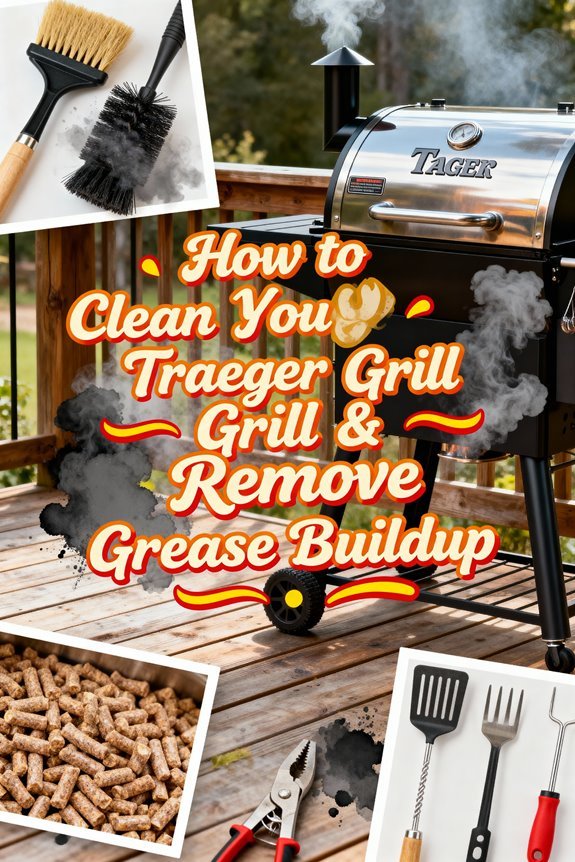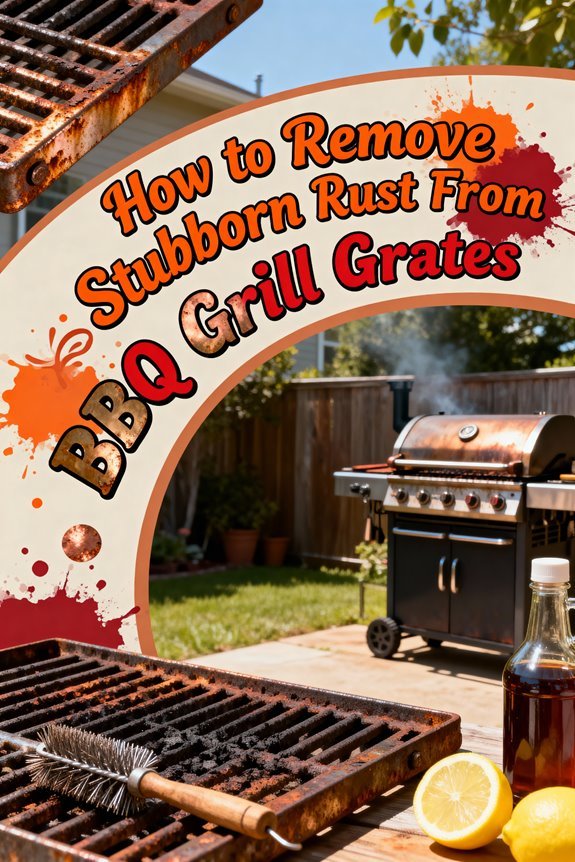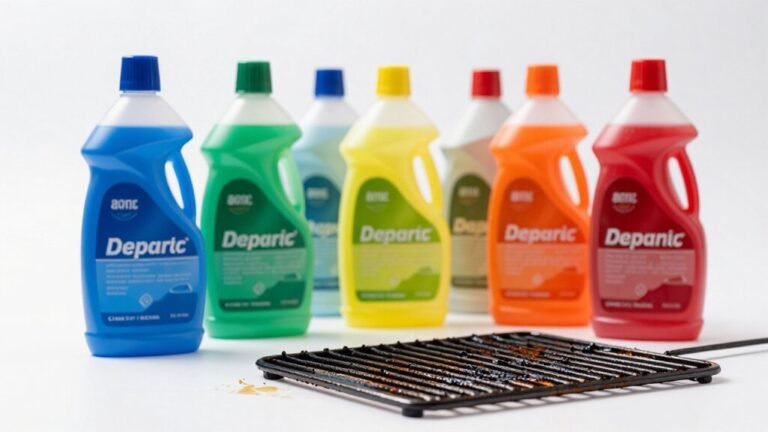To clean your Traeger grill and remove grease buildup, start by ensuring it’s completely cool and unplugged. Vacuum ash from the firepot, then remove and clean the grill grates, drip tray, and heat baffle using a non-abrasive brush and natural degreaser. Wipe down interior walls, clear sawdust from the pellet hopper and auger tube, and clean the exterior with microfiber cloths. Regular maintenance every 2-3 cooks prevents performance issues, while monthly deep cleaning extends your grill’s lifespan and optimizes flavor—there’s much more to mastering this essential routine.
Preparing Your Traeger Grill for Cleaning
Safety comes first when preparing your Traeger grill for cleaning. Verify your grill is completely cool before starting—this prevents burns and allows you to handle components safely. Disconnect from power sources if you’ll be working near electrical elements. These safety tips apply regardless of your cleaning frequency. Use a mild soap solution like you would on a Weber grill to avoid damaging finishes. Similar to a George Foreman grill, use only plastic utensils when handling surfaces to prevent scratches.
Gather your tools before disassembling anything: non-abrasive nylon brushes, grill grate hooks, shop vacuum, and an all-natural degreaser. Avoid steel wool or harsh chemicals that’ll damage surfaces. Remove the grill grates, drip tray, heat baffle, and grease chute carefully to prevent bending or breaking parts.
Empty your pellet hopper completely and vacuum residual sawdust—this prevents clogging and verifies efficient pellet feed. After removing pellets, inspect the hopper for moisture or mold and wipe it down with a dry cloth to maintain optimal pellet storage conditions. Arrange your cleaning supplies within reach to maintain workflow throughout the process.
Deep Cleaning the Interior and Removing Grease
Once you’ve disassembled your Traeger’s key components, tackle grease buildup methodically to maintain safe operation and ideal flavor. Apply one of the best degreasers—Traeger’s All-Natural Grill Cleaner or a dish soap-vinegar mix—to the drip tray, grease chute, and interior surfaces. Let it soak several minutes to loosen hardened residue before wiping with heavy-duty paper towels. Use tongs or sticks to reach tight chutes and corners. For stubborn deposits, try using Bar Keepers Friend for safe and effective removal. For grates specifically, use aluminum foil balls combined with baking soda paste to safely scrub away tough residue.
Next, vacuum loose ash from the firepot and grill chamber to optimize airflow. Clean beneath heat shields and inside the chimney where soot accumulates. Wipe interior walls with moderate cleaner—excessive scrubbing strips grill seasoning that enhances flavor. Periodically disassemble the smoke stack for thorough cleaning. Finally, vacuum the pellet hopper and auger tube to prevent dust clogs affecting ignition. Check the hopper and auger tube for sawdust buildup and blockages that can interfere with pellet flow.
Cleaning Grill Grates, Drip Tray, and Heat Baffle
After deep cleaning your Traeger’s interior, shift focus to the components that experience the most direct cooking exposure. Proper grate care demands removing grill grates every 2-3 cooks, scraping residue with nylon brushes or silicone tools, then spraying with all-natural cleaner or dish soap-vinegar mixture. Wipe clean with disposable towels to prevent grease cross-contamination. Using vinegar and baking soda creates an effective natural cleaning solution for stubborn grime. For best results, heat the grates to 400 degrees Fahrenheit to help soften stuck-on debris before cleaning.
For grease reduction, remove the drip tray monthly using non-chemical degreasers and soft brushes—never steel wool, which causes rust. Replace liners regularly and air dry completely before reinstalling.
Clean the heat baffle simultaneously, wiping grease and ash with approved cleaners. Inspect the underside for creosote buildup and confirm grease chutes remain unclogged. Deep clean grates every 20 cooking hours, drip trays and heat baffles monthly, maintaining ideal performance and flavor integrity. For quicker maintenance, clean your grates while they’re still warm to make the scraping process faster and more effective.
[affiai keyword=”grill grate cleaning tools and brushes” template=”carousel” count=”3″
Maintaining the Pellet Hopper and Fuel System
Your Traeger’s pellet hopper and fuel delivery system require systematic maintenance to prevent jams, combustion failures, and performance degradation. Always power down and unplug before servicing. Proper hopper hygiene starts with removing residual pellets—use your shop vacuum or the cleanout door on newer models. Vacuum sawdust from the hopper barrel, auger tube, and bottom chamber to eliminate blockage risks. Inspect for moisture or mold, wiping surfaces with a dry cloth to preserve pellet integrity. Regular maintenance helps prevent rust and deterioration of critical grill components. Much like maintaining indirect heat zones on gas grills, proper temperature control depends on clean, well-maintained components.
For fuel management, avoid prolonged pellet storage in the hopper, which invites moisture absorption and degradation. Empty leftover pellets after cooking sessions. Use only Traeger-brand wood pellets for ideal system compatibility. Clean the firepot regularly to maintain airflow and prevent ash-related fire extinguishment on low settings. Essential tools include a Craftsman shop vacuum, heavy-duty shop towels, and a trigger spray cleaner for thorough hopper surface cleaning.
[affiai keyword=”pellet grill hopper maintenance tools” template=”carousel” count=”3″
Exterior Cleaning and Ongoing Maintenance Schedule
While internal components handle combustion and smoke production, your Traeger’s exterior demands equal attention to preserve its appearance and prevent long-term corrosion. Spray non-toxic degreaser across the barrel, lid, and side panels, allowing several minutes to penetrate accumulated grease. Wipe down with microfiber cloths, targeting vents, hinges, and seams where grime collects. Rinse minimally and dry thoroughly to prevent rust formation.
Effective exterior maintenance tips include post-cook wipe-downs before residue hardens and weekly spot-cleaning of handles and control panels. Just like indirect heat grilling helps prevent excessive grease buildup when cooking items like baked potatoes, monthly deep cleans with degreasers maintain finish integrity, while quarterly washes with mild detergent restore appearance. Essential grease prevention strategies involve using protective covers between sessions and positioning your grill away from airborne contaminants. Always ensure your gas valve connections are clean and secure when performing maintenance checks. Inspect seals regularly to prevent leakage, and address any coating damage immediately with touch-up applications. Schedule a yearly deep cleaning, ideally during warm weather when you can work comfortably outdoors and allow all components to dry completely.
[affiai keyword=”grill exterior cleaner degreaser maintenance supplies” template=”carousel” count=”3″







